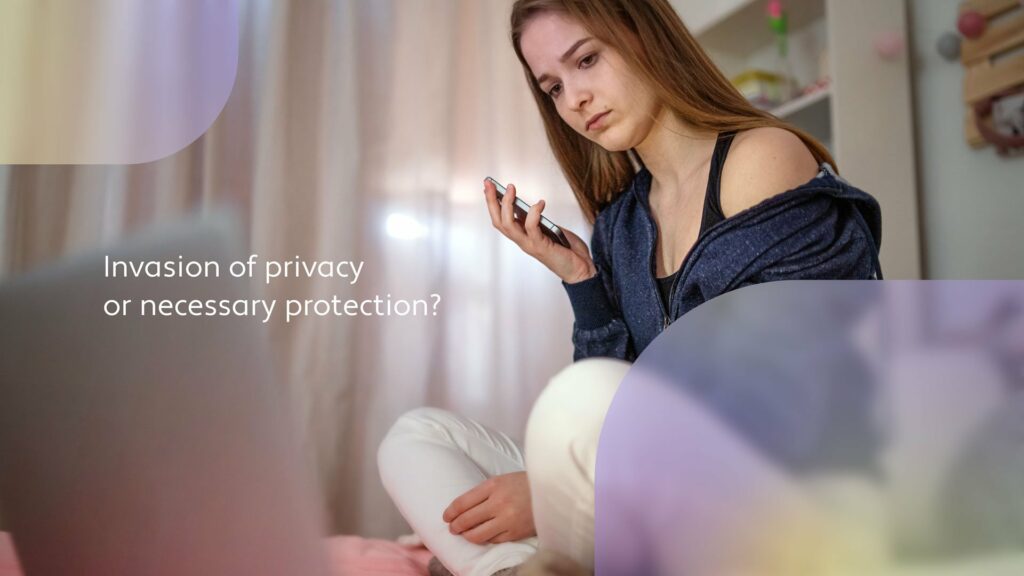Invasion of privacy or necessary protection? Learn how to balance your child’s need for independence with protecting them from cyberbullying.

When kids reach their tweens or teens, they start exploring and developing their identities. Seeking greater independence from the family is a natural part of that. But how do you ensure that the privacy kids need doesn’t leave you in the dark about cyberbullying or other negative experiences?
From cyberbullying to sexting: Understanding the danger zones
It can be difficult enough in day-to-day life to strike the right balance between the freedom young people crave and the guidance they still need. How do you manage that tightrope walk online, especially if your kids are more tech savvy than you are?
A good place to start is understanding what dangers the digital world holds. This breakdown should give you a clearer picture of risky situations and the issues that arise from them:
- Harmful content: Whether kids think they're ready for adult material or accidentally stumble across it, they often find it disturbing. The Web is full of content that’s unsuitable for impressionable minds. Think of pornography and sexually explicit content, real or simulated violence, hate and terrorist sites.
- Harmful conduct: Kids are at risk of engaging in or becoming the victim of hurtful of harmful behaviours. These include cyberbullying, sexting, misusing others’ login details to reveal personal information or impersonate them, making unauthorised purchases on credit cards as well as struggling to limit the amount of time spent online.
- Harmful contacts: Not everyone is who they pretend to be online. Your child could be chatting with sexual and other predators posing as kids or interacting with scammers.
- Harmful contracts: This is when teens sign up to contracts or terms and conditions they don't fully understand. Unscrupulous vendors can then steal their identities or collect and sell personal data.
But it’s not that bad in South Africa, is it?
As a Digimune survey of 200 South African parents found, these things don’t just happen to kids in other countries.
A sobering 54% had accessed inappropriate digital content, 51.5% had fallen victim to cyberbullying and 43.5% had willingly shared personal information online.
Bottom line? Get as actively involved in your child’s digital life as you are in the rest of their lives. A Forbes report on an American study serves as a warning to parents. The second most common reason teens don’t tell their parents about upsetting incidents online is they’re afraid of a negative reaction. The first is they thought it was “no big deal”.

Digital parenting 101
Before your teen goes out, they have to answer some questions: Where are you going? Who are you going with? What will you be doing? When will you be home? The same goes for the digital world. They can’t just run wild online.
That said, secretly following your kids when they’re out with friends would be creepy. Ditto for going behind their backs to monitor their online activities. After all, you should aim to be a role model for your children online and off. And that’s precisely the kind of underhand behaviour you hope they’ll steer clear of themselves.
And if you discover your child is a victim of cyberbullying, you’ll have to reveal your snooping. How receptive to your advice will they be then?
Supervision not spying – managing privacy and protection
You want to build a trusting relationship with your child. Then, if they fall victim to cyberbullying or have a bad experience online, they know they can turn to you. In short, you want them to talk openly with you about their digital lives.
With that in mind, stress that cyberbullying is never your child’s fault. And don’t undermine that message with “punishments”, such as reducing screen time or confiscating devices, to stop the harassment. You don’t want your child to think they’re to blame after all. Instead, tell them you’ll work together to block the bully and tighten privacy settings.
Even when kids don’t talk about facing harassment, an ongoing dialogue about their digital lives gives you a baseline. With an understanding of your child’s digital activities, you’ll find it easier to identify changes. Our article on the signs of cyberbullying will help you spot any red flags.
Your dialogue about all things digital should start with establishing your “house rules” – aka parental controls. These are the dos and don’ts that apply to how kids can use devices, apps, media and more.
Interestingly, there is evidence from UK research that 65% of teens aged 11 to 16 think parental controls are a good idea.
First rule of parental controls: Talk about parental controls
In order to get your kids’ buy-in, consider negotiating digital rules as a family. This is a good way to ensure children understand why the rules are there. Plus, it helps avoid punishments that discourage teens from being open with you.
Once everyone has agreed on the rules, make sure kids adhere to them. If they see they can get away with more screen time, why should they stick to the limits? You’ll look like a hypocrite insisting they shouldn’t be endlessly texting and scrolling when you do the same. So remember to set a good example.
Rewarding good digital behaviour is just as important as punishing bad. Part of that is loosening the reins and offering greater online freedom as your kids mature and earn your trust.
But aside from taking a teen’s phone to review browser histories, email and social media channels, how do you check up them? Even if they are sticking to the rules, teenagers are impulsive and lack critical decision-making skills. They can all too easily fall prey to cyberbullying and more through no fault of their own.

How parental monitoring software can shield kids from cyberbullying
When you install parental control apps, you can not only prevent cyberbullying before it starts but also make inappropriate content inaccessible. As an added bonus, you monitor risky areas of their digital lives without combing through everything on their phones.
Here’s a list of some of the features you might want to prioritise. Of course, you should decide what measures to implement based on your child’s age, personality and ability to handle responsibility.
- Receive instant alerts about suicidal tendencies and cyberbullying.
- Select trigger words and receive a notification whenever these appear in your child’s communications.
- Install filters to block undesirable applications and websites.
- Manage the length of time your child uses apps and services as well as restrict their functionality.
- Monitor texts and emails.
- Locate your child using GPS tracking.
- Ensure the device’s phone book prevents suspicious numbers from communicating with your child.
If despite your best efforts, you notice the signs of cyberbullying, parental control software can be a great source of evidence. While blocking the offender will give your child relief, don’t delay in taking screenshots and saving multimedia files.
Materials on some apps, such as Snapchat, disappear after a short period. This makes these platforms a favourite with bullies who think they can get away with cruel content. If you decide to present your case to the police, school or culprit’s parents, you’ll have everything on hand.
We share in your parental role by giving you more digital control
It’s not easy to keep up with kids’ online and app crazes – not to mention the digital slang (OMG). Digimune offers a comprehensive parental control solution that can help to protect your kids from cyberbullying and other dangers.
Why not browse our products or contact us, so we can help you raise a generation of happy, healthy and digitally savvy kids.




